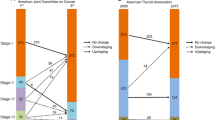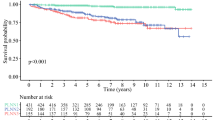Abstract
Introduction
Epidemiologically, thyroid gland tumors are lesions of the highest importance among endocrine tumors in humans. Although the results of surgical treatment of the highly differentiated (follicular and papillary) tumors seem to be satisfactory, treatment of the poorly differentiated (medullary and anaplastic) tumor still demands clinical and basic investigations. In this study the authors sought to evaluate clinical and molecular factors that could contribute to preoperative detection of more advanced thyroid cancers (i.e., those that exhibit extrathyroid spread and lymph node invasion).
Methods
A total of 27 patients operated on for thyroid cancer were evaluated according to age, sex, time from the onset of the disease, cytogenetic changes, and loss of heterozygosity (LOH) in 14 microsatellite markers. The output variables were defined according to postoperative findings and the TNM 2002 score. The T1-2 N0 M0 cases were defined as local malignancy (LM); and T3-4 any N any M, any T N1 any M, or any T any N M1 were considered advanced malignancy (AM). The control groups consisted of 25 patients with multinodular goiter (MNG) and 32 patients with follicular adenoma (FA). In all cases, clinical and molecular data similar to those listed above were collected, excluding staging and follow-up information.
Results
There was no predominant specific type of chromosomal aberration observed and no marker lost in more than five patients (18%). The logistic regression identified three input variables as contributing significantly to the dichotomized outcome measure (LM vs. AM): LOH in any of the examined loci, age of the patient at the presentation, and the sex of the patient. Furthermore, discriminant analysis revealed four input variables differentiating among TC, FA, and MNG patients. Based on the multivariate analysis results, two numeric prognostic scales were fashioned: LAST-1, a scale applicable to differentiation of thyroid cancers at different degrees of clinical advancement; and LAST-2, a scale applicable to differentiation of any thyroid lumps.
Conclusions
It was concluded that LOH and the age and sex of the patients can provide sufficient data to predict thyroid cancer with a high degree of clinical advancement. LAST-1 scale is a reliable tool for identifying these patients. The LAST-2 scale gives supportive information about the character of thyroid lumps, distinguishing TC from MNG and FA.







Similar content being viewed by others
References
Pacini F, De Groot LJ. Thyroid neoplasia. http://www.thyroidmanager.org, 2004
Voutilainen PE, Multanen MM, Leppaniemi AK, et al. Prognosis after lymph node recurrence in papillary thyroid carcinoma depends on age. Thyroid 2001;11:953–957
Antonini P, Venuat AM, Lineares G, et al. Cytogenetic abnormalities in thyroid adenomas. Cancer Genet Cytogenet 1991;52:157–164
Gertner ME, Kebebew E. Multiple endocrine neoplasia type 2. Curr Treat Options Oncol 2004;5:315–325
Bornstein-Quevedo L, Garcia-Hernandez ML, Camacho-Arroyo I, et al. Telomerase activity in well-differentiated papillary thyroid carcinoma correlates with advanced clinical stage of the disease. Endocr Pathol 2003;14:213–219
Kimura ET, Nikiforova MN, Zhu Z, et al. High prevalence of BRAF mutations in thyroid cancer: genetic evidence for constitutive activation of the RET/PTC-RAS-BRAF signaling pathway in papillary thyroid carcinoma. Cancer Res 2003;63:1454–1457
Lacroix L, Mian C, Barrier T, et al. PAX8 and peroxisome proliferator-activated receptor gamma 1 gene expression status in benign and malignant thyroid tissues. Eur J Endocrinol 2004;151:367–374
Anwar F, Emond MJ, Schmidt RA, et al. Retinoblastoma expression in thyroid neoplasms. Mod Pathol 2000;13:562–569
Granja F, Morari J, Morari EC, et al. Proline homozygosity in codon 72 of p53 is a factor of susceptibility for thyroid cancer. Cancer Lett 2004;210:151–157
Boltze C, Zack S, Quednow C, et al. Hypermethylation of the CDKN2/p16INK4A promotor in thyroid carcinogenesis. Pathol Res Pract 2003;199:399–404
Putzer BM, Drosten M. The RET proto-oncogene: a potential target for molecular cancer therapy. Trends Mol Med 2004;10:351–357
Tallini G. Molecular pathobiology of thyroid neoplasms. Endocr Pathol 2002;13:271–288
Inaba M, Sato H, Abe Y, et al. Expression and significance of c-met protein in papillary thyroid carcinoma. Tokai J Exp Clin Med 2002;27:43–49
Wang DG, Liu WH, Johnston CF, et al. Bcl-2 and c-Myc, but not bax and p53, are expressed during human medullary thyroid tumorigenesis. Am J Pathol 1998;152:1407–1413
Kataki A, Sotirianakos S, Memos N, et al. P53 and C-FOS overexpression in patients with thyroid cancer: an immunohistochemical study. Neoplasma 2003;50:26–30
Hunt JL, Yim JH, Tometsko M, et al. Loss of heterozygosity of the VHL gene identifies malignancy and predicts death in follicular thyroid tumors. Surgery 2003;134:1043–1047
Jeanpierre M, Junien C. DNA analysis as clinical investigation: when and how? Ann Genet 1984;27:134–147
Slebos RJ, Umbach DM, Sommer CA, et al. Analytical and statistical methods to evaluate microsatellite allelic imbalance in small amounts of DNA. Lab Invest 2004;84:649–657
Sperling K, Wiesner R. A rapid banding technique for routine use in human and comparative cytogenetics. Humangenetik 1972;15:349–353
Mitelman F. An International System for Cytogenetic Nomenclature. Basel, Karger, 1995
Cady B, Rossi R. An expanded view of risk-group definition in differentiated thyroid carcinoma. Surgery 1988;104:947–953
Van Nguyen K, Dilawari RA. Predictive value of AMES scoring system in selection of exent of surgery in well differentiated carcinoma of thyroid. Am J Surg 1995;61:151–155
Hay ID, Thompson GB, Grant CS, et al. Papillary thyroid carcinoma managed at the Mayo Clinic during six decades (1940–1999): temporal trends in initial therapy and long-term outcome in 2444 consecutively managed patients. World J Surg 2002;26:879–885
Byar DP, Green SB, Dor P, et al. Prognostic index for thyroid carcinoma: study of the EORTC thyroid cancer cooperative group. Eur J Cancer 1979;15:1033–1041
Goldgar DE, Easton DF, Cannon-Albright LA, et al. Systematic population-based assessment of cancer risk in first-degree relatives of cancer probands. J Natl Cancer Inst 1994;86:1600–1608
Fagin JA. Thyroid Cancer. Norwell, MA, Kluwer, pp 59–84
Huang Y, Prasad M, Lemon WJ, et al. Gene expression in papillary thyroid carcinoma reveals highly consistent profiles. Proc Natl Acad Sci USA 2001;98:15044–15049
Links TP, van Tol KM, Meerman GJ, et al. Differentiated thyroid carcinoma: a polygenic disease. Thyroid 2001;11:1135–1140
Rodrigues RF, Roque L, Rosa-Santos J, et al. Chromosomal imbalances associated with anaplastic transformation of follicular thyroid carcinomas. Br J Cancer 2004;90:492–496
Ito Y, Yoshida H, Tomoda C, et al. Decreased expression of p107 is correlated with anaplastic transformation in papillary carcinoma of the thyroid. Anticancer Res 2003;23:3819–3824
Nikiforov YE. Genetic alterations involved in the transition from well-differentiated to poorly differentiated and anaplastic thyroid carcinomas. Endocr Pathol 2004;15:319–327
Burzykowski T, Chmielarczyk W. Predicted and observed thyroid cancer incidence in Poland after year 1986. Wiad Lek 2004;57:306–310
Haigh PI, Urbach DR, Rotstein LE. Extent of thyroidectomy is not a major determinant of survival in low- or high-risk papillary thyroid cancer. Ann Surg Oncol 2005;12:81–89
Clark JR, Lai P, Hall F, et al. Variables predicting distant metastases in thyroid cancer. Laryngoscope 2005;115:661–667
Zedenius J, Wallin G, Svensson A, et al. Deletions of the long arm of chromosome 10 in progression of follicular thyroid tumors. Hum Genet 1996;97:299–303
Cerutti JM, Delcelo R, Amadei MJ, et al. A preoperative diagnostic test that distinguishes benign from malignant thyroid carcinoma based on gene expression. J Clin Invest 2004;113:1234–1242
Rosai J. Immunohistochemical markers of thyroid tumors: significance and diagnostic applications. Tumori 2003;89:517–519
Sheikh HA, Tometsko M, Niehouse L, et al. Molecular genotyping of medullary thyroid carcinoma can predict tumor recurrence. Am J Surg Pathol 2004;28:101–106
Hunt JL, Yim JH, Tometsko M, et al. Loss of heterozygosity of the VHL gene identifies malignancy and predicts death in follicular thyroid tumors. Surgery 2003;134:1043–1047
Passler C, Prager G, Scheuba C, et al. Application of staging systems for differentiated thyroid carcinoma in an endemic goiter region with iodine substitution. Ann Surg 2003;237:227–234
Rodriguez-Cuevas S, Labastida-Almendaro S, Cortes-Arroyo H, et al. Multifactorial analysis of survival and recurrences in differentiated thyroid cancer: comparative evaluation of usefulness of AGES, MACIS, and risk group scores in Mexican population. J Exp Clin Cancer Res 2002;21:79–86
Hadjieva T. Scoring patients’ risk in differentiated thyroid cancer. Onkologie 2001;24:561–568
Khalid A, Pal R, Sasatomi E, et al. Use of microsatellite marker loss of heterozygosity in accurate diagnosis of pancreaticobiliary malignancy from brush cytology samples. Gut 2004;53:1860–1865
Ward LS, Brenta G, Medvedovic M, et al. Studies of allelic loss in thyroid tumors reveal major differences in chromosomal instability between papillary and follicular carcinomas. J Clin Endocrinol Metab 1998;83:525–530
Oriola J, Halperin I, Mallofre C, et al. Screening of selected genomic areas potentially involved in thyroid neoplasms. Eur J Cancer 2001;37:2470–2474
Grebe SK, McIver B, Hay ID, et al. Frequent loss of heterozygosity on chromosomes 3p and 17p without VHL or p53 mutations suggests involvement of unidentified tumor suppressor genes in follicular thyroid carcinoma. J Clin Endocrinol Metab 1997;82:3684–3691
Trovato M, Fraggetta F, Villari D, et al. Loss of heterozygosity of the long arm of chromosome 7 in follicular and anaplastic thyroid cancer, but not in papillary thyroid cancer. J Clin Endocrinol Metab 1999;84:3235–3240
Kitamura Y, Shimizu K, Ito K, et al. Allelotyping of follicular losses in chromosome arms 7q, 11p and 22q. J Clin Endocrinol Metab 2001;86:4268–4272
Zedenius J, Wallin G, Svensson A, et al. Deletions of the long arm of chromosome 10 in progression of follicular thyroid tumors. Hum Genet 1996;97:299–303
Yeh JJ, Marsh DJ, Zedenius J, et al. Fine-structure deletion mapping of 10q22-24 identifies regions of loss of heterozygosity and suggests that sporadic follicular thyroid adenomas and follicular thyroid carcinomas develop along distinct neoplastic pathways. Genes Chromosome Cancer 1999;26:322–328
Sobin LH, Wittekind C, editors. TNM Classification of Malignant Tumors, 6th edition. New York: Wiley-Liss, 2002:52–56
Witt RL, McNamara AM. Prognostic factors in mortality and morbidity in patients with differentiated thyroid cancer. Ear Nose Throat J 2002;81:856–863
Alzahrani AS, Al Mandil M, Chaudhary MA, et al. Frequency and predictive factors of malignancy in residual thyroid tissue and cervical lymph nodes after partial thyroidectomy for differentiated thyroid cancer. Surgery 2002;131:443–449
Shaha AR. Implications of prognostic factors and risk groups in the management of differentiated thyroid cancer. Laryngoscope 2004;114:393–402
D’Avanzo A, Treseler P, Ituarte PH, et al. Follicular thyroid carcinoma: histology and prognosis. Cancer 2004;100: 1123–1129
Rios A, Rodriguez JM, Canteras M, et al. Risk factors for malignancy in multinodular goitres. Eur J Surg Oncol 2004;30:58–62
Eichhorn W, Tabler H, Lippold R, et al. Prognostic factors determining long-term survival in well-differentiated thyroid cancer: an analysis of four hundred eighty-four patients undergoing therapy and aftercare at the same institution. Thyroid 2003;13:949–958
Acknowledgments
The authors express their gratitude to Prof. Janusz Limon and his team for performing the LOH and cytogenetic analyses. The study was supported by a KBN (Polish Scientific Committee) grant.
Author information
Authors and Affiliations
Corresponding author
Rights and permissions
About this article
Cite this article
Lachinski, A.J., Stefaniak, T., Kobiela, J. et al. New Prognostic Scales LAST-1 and LAST-2: Supporting Prediction and Staging of Thyroid Cancer. World J. Surg. 30, 309–320 (2006). https://doi.org/10.1007/s00268-005-0277-5
Published:
Issue Date:
DOI: https://doi.org/10.1007/s00268-005-0277-5




